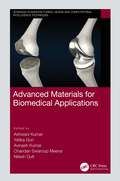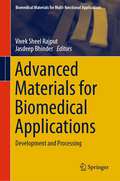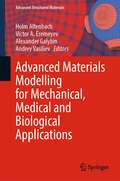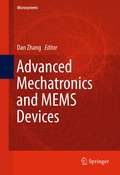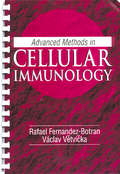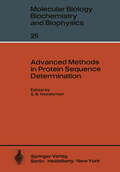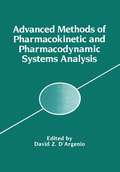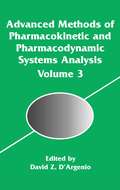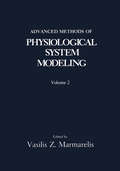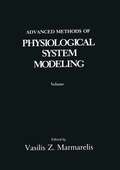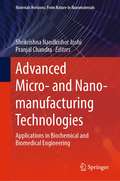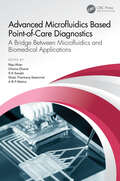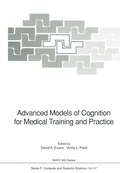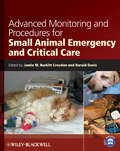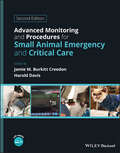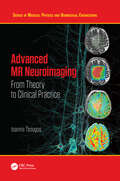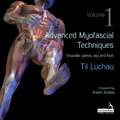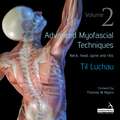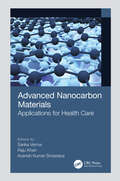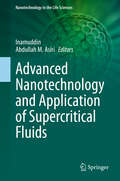- Table View
- List View
Advanced Materials for Biomedical Applications (Advances in Manufacturing, Design and Computational Intelligence Techniques)
by Ashwani Kumar Yatika Gori Avinash Kumar Chandan Swaroop Meena Nitesh DuttThe text discusses synthesis, processing, design, simulation and characterization of biomaterials for biomedical applications. It synergizes exploration related to various properties and functionalities in the biomedical field through extensive theoretical and experimental modeling. It further presents advanced integrated design and nonlinear simulation problems occurring in the biomedical engineering field. It will serve as an ideal reference text for senior undergraduate and graduate students, and academic researchers in fields including biomedical engineering, mechanical engineering, materials science, ergonomics, and human factors. The book Employs a problem-solution approach, where, in each chapter, a specific biomedical engineering problem is raised and its numerical, and experimental solutions are presented. Covers recent developments in biomaterials such as OPMF/KGG bio composites, PEEK-based biomaterials, PF/KGG biocomposites, oil palm mesocarp Fibre/KGG biocomposites, and polymeric resorbable materials for orthopedic, dentistry and shoulder arthroplasty applications. Discusses mechanical performance and corrosive analysis of biomaterials for biomedical applications in detail. Presents advanced integrated design and nonlinear simulation problems occurring in the biomedical engineering field. Presents biodegradable polymers for various biomedical applications over the last decade owing to their non-corrosion in the body, biocompatibility and superior strength in growing state. Synergizes exploration related to the various properties and functionalities in the biomedical field through extensive theoretical and experimental modeling.
Advanced Materials for Biomedical Applications: Development and Processing (Biomedical Materials for Multi-functional Applications)
by Vivek Sheel Rajput Jasdeep BhinderThis book provides an insight into the basic fundamentals of the biomaterials used for the biomedical applications, their development and processing techniques. Advanced materials are significantly utilized for the biomedical applications ranging from dental devices to cancer treatment owing to their higher biocompatibility and better interaction with tissues. This book covers the various topics that include basic biocompatibility phenomena, insight to materials science, class of different advanced materials as a biomaterials, development and processing techniques, design and analysis of the developed advanced materials, investigation of its properties and major applications. Recent information regarding the development techniques and methods for improving the properties of the advanced materials in the field of biomedical applications is highlighted in detail. The textbook offers clear explanation of the text in the chapters with self-explanatory figures and tables. It demonstrates the novel methods, opportunities and ideas for developing biomaterials in the field of biomedical applications. It also includes critical review study of the developed advanced materials for biomedical applications in a new summarized form. The inclusion of the discussions on hybrid polymer-based composites and self-healing composite materials offers a special feature in the textbook. It features a thorough overview of the simulation aspect in the biomedical applications. The book features at least 50% of its references from last three–four years’ work in the field of biomaterials and biomedical. The book content adds to the redundancy in the literature work related to biomedical and biomaterials.This book is a valuable resource for academicians, students and scholars from science and engineering background having interest in biomaterials. It is helpful to the biomedical engineering group especially in countries or location where they don’t have access to the major journals.
Advanced Materials Modelling for Mechanical, Medical and Biological Applications (Advanced Structured Materials #155)
by Holm Altenbach Victor A. Eremeyev Alexander Galybin Andrey VasilievThe book is devoted to the 70th birthday of Prof. Sergey M. Aizikovich, which will celebrated on August 2nd 2021. His scientific interests are related to the following topics: Mechanics of contact interactions, Functionally graded materials, Mechanics of fracture, Integral equations of mathematical physics, Inverse problems of the theory of elasticity, and Applications of elasticity to biological and medical problems of mechanics of materials. The papers, collected in the book, are contributions of authors from 10 countries.
Advanced Mechatronics and MEMS Devices (Microsystems #23)
by Dan ZhangAdvanced Mechatronics and MEMS Devicesdescribes state-of-the-art MEMS devices and introduces the latest technology in electrical and mechanical microsystems. The evolution of design in microfabrication, as well as emerging issues in nanomaterials, micromachining, micromanufacturing and microassembly are all discussed at length in this volume. Advanced Mechatronics also provides a reader with knowledge of MEMS sensors array, MEMS multidimensional accelerometer, artificial skin with imbedded tactile components, as well as other topics in MEMS sensors and transducers. The book also presents a number of topics in advanced robotics and an abundance of applications of MEMS in robotics, like reconfigurable modular snake robots, magnetic MEMS robots for drug delivery and flying robots with adjustable wings, to name a few.
Advanced Methods in Cellular Immunology
by Rafael Fernandez-Botran Vaclav VetvickaImmunologists as well investigators in other disciplines may often use protocols involving the isolation, cultures and characterization of different types of leukocytes. Advanced Methods in Cellular Immunology is a collection of techniques in an easy-to-use format.Each chapter provides readers with related program information, a step-by-step de
Advanced Methods in Protein Sequence Determination (Molecular Biology, Biochemistry and Biophysics Molekularbiologie, Biochemie und Biophysik #25)
by Russell F. Doolittle H. Falter M. J. Horn K. K. Kannan R. A. Laurson G. A. Mross S. B. Needleman E. Nieboer M. ReichlinConfusion now hath made his masterpiece Macbeth II iii 72 Whence and what are those execrable shape? Paradise Lost Ib 1 681 Confusion worse confounded Paradise Lost Ib 1 995 When the manuscript for the first part of this book was proposed, it was anticipated that the discussion of the entire field of protein se quencing could be covered in a single volume - from purification and characterization of the protein through fragmentation by chemical or enzymic means and, finally, to reassembly of the identified individual peptides into the reconstructed total sequence. It soon became evident that this would not be possible. While the intent was to restrict the expose of procedures only to that information concerned with "hands on" wet chemistry, it became apparent that a thorough presentation would require, in addition, a discussion of certain instrumental and more theoretical approaches not included in the first volume. Furthermore, the entire understanding of the field of protein sequencing has advanced appreciably since the inception of this book. The purpose of the first volume was to provide practical information in sufficient detail to permit the researcher to undertake the actual sequencing procedures in his own laboratory.
Advanced Methods of Pharmacokinetic and Pharmacodynamic Systems Analysis
by Marcos BrianoThis volume records the proceedings of the Workshop on Advanced Meth ods of Pharmacokinetic and Pharmacodynamic Systems Analysis, organized by the Biomedical Simulations Resource in May 1990. The meeting brought together over 120 investigators from a number of disciplines, including clinical pharmacology, clinical pharmacy, pharmaceutical science, biomathematics, statistics and biomed ical engineering with the purpose of providing a high-level forum to facilitate the exchange of ideas between basic and clinical research scientists, experimentalists and modelers working on problems in pharmacokinetics and pharmacodynamics. It has been my experience that in many areas of biomedical research, when a meeting of this type is held, the general attitude of those experimentalists willing to attend is one of extreme skepticism: as a group they feel that mathematical modeling has little to offer them in furthering their understanding of the particular biological processes they are studying. This is certainly not the prevailing view when the topic is pharmacokinetics and drug response. Quite the contrary, the use of mathemati cal modeling and associated data analysis and computational methods has been a central feature of pharmacokinetics almost from its beginnings. In fact, the field has borrowed techniques of modeling from other disciplines including applied math ematics, statistics and engineering, in an effort to better describe and understand the processes of drug disposition and drug response.
Advanced Methods of Pharmacokinetic and Pharmacodynamic Systems Analysis (The Springer International Series in Engineering and Computer Science #765)
by David D'ArgenioAdvanced Methods of Pharmacokinetic and Pharmocodynamic Systems Analysis Volume 3 is vital to professionals and academicians working in drug development and bioengineering. Both basic and clinical scientists will benefit from this work.This book contains chapters by leading researchers in pharmacokinetic/pharmacodynamic modeling and will be of interest to anyone involved with the application of pharmacokinetic and pharmacodynamics to drug development. The use of mathematical modeling and associated computational methods is central to the study of the absorption, distribution and elimination of therapeutic drugs (pharmacokinetics) and to understanding how drugs produce their effects (pharmacodynamics). From its inception, the field of pharmacokinetics and pharmacodynamics has incorporated methods of mathematical modeling, simulation and computation in an effort to better understand and quantify the processes of uptake, disposition and action of therapeutic drugs. These methods for pharmacokinetic/pharmacodynamic systems analysis impact all aspects of drug development. In vitro, animal and human testing, as well as drug therapy are all influenced by these methods. Modeling methodologies developed for studying pharmacokinetic/ pharmacodynamic processes confront many challenges. This is related in part to the severe restrictions on the number and type of measurements that are available from laboratory experiments and clinical trials, as well as the variability in the experiments and the uncertainty associated with the processes themselves. The contributions are organized in three main areas: Mechanism-Based PK/PD, Pharmacometrics and Pharmacotherapy. Both professionals and academics will profit from this extensive work.
Advanced Methods of Physiological System Modeling: Volume 2
by V. Z. MarmarelisThis volume is the second in a series of publications sponsored by the Biomedical Simulations Resource (BMSR) at the University of Southern California that report on recent research developments in the area of physiological systems modeling and anal ysis of physiological signals. As in the first volume of this series, the work reported herein is concerned with the development of advanced methodologies and their novel application to problems of biomedical interest, with emphasis on nonlinear aspects of physiological function. The term "advanced methodologies" is used to indicate that the scope of this work extends beyond the ordinary type of analysis used by most investigators in this area, which is confined primarily in the linear domain. As the im portance of nonlinearities in understanding the complex mechanisms of physiological function is increasingly recognized, the need for effective and practical methodolo gies that address the issue of nonlinear dynamics in life sciences becomes more and more pressing. The publication of these volumes and the workshops, organized by the BMSR on the same subject, are two key activities in our efforts to promote and intensify research in this area, foster interaction and collaboration among interested investigators, and disseminate recent results throughout the biomedical community.
Advanced Methods of Physiological System Modeling: Volume 3
by V. Z. MarmarelisThis volume is the third in a series entitled" Advanced Methods of Physiological System Modeling" and the fifth in a series of research volumes published by Plenum under the sponsorship of the Biomedical Simulations Resource (BMSR) at the Uni versity of Southern California in the context of dissemination activities supported by the Biomedical Research Technology Program of the National Center for Research Resources at the National Institutes of Health under Grant No. P41 RR-OI861. These volumes are edited by BMSR principal scientists and report on recent research de velopments in the area of physiological systems modeling, as well as on advanced methods for analysis of physiological signals and data. As in the previous two volumes of this series, the work reported herein is con cerned with the development of advanced modeling methodologies and their novel application to problems of biomedical interest, with emphasis on nonlinear aspects of physiological function. The term "advanced methodologies" is used to indicate that the scope of this work extends beyond the ordinary type of analysis, which is confined traditionally to the linear domain. As the importance of nonlinearities in understanding the complex mechanisms of physiological function is increasingly recognized, the need for effective and practical modeling methodologies that address the issue of nonlinear dynamics in life sciences becomes more and more pressing.
Advanced Micro- and Nano-manufacturing Technologies: Applications in Biochemical and Biomedical Engineering (Materials Horizons: From Nature to Nanomaterials)
by Shrikrishna Nandkishor Joshi Pranjal ChandraThis volume focuses on the fundamentals and advancements in micro and nanomanufacturing technologies applied in the biomedical and biochemical domain. The contents of this volume provide comprehensive coverage of the physical principles of advanced manufacturing technologies and the know-how of their applications in the fabrication of biomedical devices and systems. The book begins by documenting the journey of miniaturization and micro-and nano-fabrication. It then delves into the fundamentals of various advanced technologies such as micro-wire moulding, 3D printing, lithography, imprinting, direct laser machining, and laser-induced plasma-assisted machining. It also covers laser-based technologies which are a promising option due to their flexibility, ease in control and application, high precision, and availability. These technologies can be employed to process several materials such as glass, polymers: polycarbonate, polydimethylsiloxane, polymethylmethacrylate, and metals such as stainless steel, which are commonly used in the fabrication of biomedical devices, such as microfluidic technology, optical and fiber-optic sensors, and electro-chemical bio-sensors. It also discusses advancements in various MEMS/NEMS based technologies and their applications in energy conversion and storage devices. The chapters are written by experts from the fields of micro- and nano-manufacturing, materials engineering, nano-biotechnology, and end-users such as clinicians, engineers, academicians of interdisciplinary background. This book will be a useful guide for academia and industry alike.
Advanced Microfluidics Based Point-of-Care Diagnostics: A Bridge Between Microfluidics and Biomedical Applications
by Raju Khan Chetna Dhand Sunil Kumar Sanghi D. Shabi Thankaraj Salammal Ashtbhuja Prasad MishraThis book provides a well-focused and comprehensive overview of novel technologies involved in advanced microfluidics based diagnosis via various types of prognostic and diagnostic biomarkers. This authors examine microfluidics based diagnosis in the biomedical field as an upcoming field with extensive applications. It provides a unique approach and comprehensive technology overview for diagnosis management towards early stages of various bioanalytes via cancer diagnostics diabetes, alzheimer disease, toxicity in food products, brain and retinal diseases, cardiovascular diseases, and bacterial infections etc. Thus, this book would encompass a combinatorial approach of medical science, engineering and biomedical technology. The authors provide a well-focused and comprehensive overview of novel technologies involved in advanced microfluidics based diagnosis via various types of prognostic and diagnostic biomarkers. Moreover, this book contains detailed description on the diagnosis of novel techniques. This book would serve as a guide for students, scientists, researchers, and microfluidics based point of care technologies via smart diagnostics and to plan future research in this valuable field.
Advanced Microfluidics Based Point-of-Care Diagnostics: A Bridge Between Microfluidics and Biomedical Applications
by Raju Khan, Chetna Dhand, S. K. Sanghi, Shabi Thankaraj Salammal, and A. B. P. MishraThis book provides a well-focused and comprehensive overview of novel technologies involved in advanced microfluidics based diagnosis via various types of prognostic and diagnostic biomarkers. This authors examine microfluidics based diagnosis in the biomedical field as an upcoming field with extensive applications. It provides a unique approach and comprehensive technology overview for diagnosis management towards early stages of various bioanalytes via cancer diagnostics diabetes, alzheimer disease, toxicity in food products, brain and retinal diseases, cardiovascular diseases, and bacterial infections etc. Thus, this book would encompass a combinatorial approach of medical science, engineering and biomedical technology. The authors provide a well-focused and comprehensive overview of novel technologies involved in advanced microfluidics based diagnosis via various types of prognostic and diagnostic biomarkers. Moreover, this book contains detailed description on the diagnosis of novel techniques. This book would serve as a guide for students, scientists, researchers, and microfluidics based point of care technologies via smart diagnostics and to plan future research in this valuable field.
Advanced Models of Cognition for Medical Training and Practice (NATO ASI Subseries F: #97)
by David A. Evans Vimla L. PatelCognitive science is a multidisciplinary science concerned with understanding and utilizing models of cognition. It has spawned a great dealof research on applications such as expert systems and intelligent tutoring systems, and has interacted closely with psychological research. However, it is generally accepted that it is difficult to apply cognitive-scientific models to medical training and practice. This book is based on a NATO Advanced Research Workshop held in Italy in 1991, the purpose of which was to examine the impact ofmodels of cognition on medical training and practice and to outline future research programmes relating cognition and education, and in particular to consider the potential impact of cognitive science on medical training and practice. A major discovery presented in the book is that the research areas related to artificial intelligence, cognitive psychology, and medical decision making are considerably closer, both conceptually and theoretically, than many of the workshop participants originally thought.
Advanced Monitoring and Procedures for Small Animal Emergency and Critical Care
by Jamie M. Burkitt Creedon Harold DavisAdvanced Monitoring and Procedures for Small Animal Emergency and Critical Care is a comprehensive yet practical reference, providing hands-on information essential to veterinarians and veterinary technicians involved in emergency and critical care. Written by an expert team of veterinarians and veterinary technicians, this well-referenced book offers step-by-step protocols for performing advanced emergency and critical care procedures and monitoring techniques. Packed with practical guidance in an easy-to-use format, this book is ideally suited for quick access in emergency rooms or intensive care units. Organized primarily by body system, each chapter covers general principles, indications, equipment, techniques, basic interpretation, troubleshooting, and contraindications. Standardized protocols supply equipment lists and step-by-step instructions throughout, and a companion website offers images from the book in PowerPoint and protocols as downloadable Word files. Advanced Monitoring and Procedures for Small Animal Emergency and Critical Care is a valuable resource for any veterinary staff member with an interest in improving the standard of care in emergency and critical care medicine.
Advanced Monitoring and Procedures for Small Animal Emergency and Critical Care
by Jamie M. Burkitt Creedon Harold DavisAdvanced Monitoring and Procedures for Small Animal Emergency and Critical Care is a comprehensive yet practical reference, providing hands-on information essential to veterinarians and veterinary technicians involved in emergency and critical care. Written by an expert team of veterinarians and veterinary technicians, this well-referenced book offers step-by-step protocols for performing advanced emergency and critical care procedures and monitoring techniques. Packed with practical guidance in an easy-to-use format, this book is ideally suited for quick access in emergency rooms or intensive care units. Organized primarily by body system, each chapter covers general principles, indications, equipment, techniques, basic interpretation, troubleshooting, and contraindications. Standardized protocols supply equipment lists and step-by-step instructions throughout, and a companion website offers images from the book in PowerPoint and protocols as downloadable Word files. Advanced Monitoring and Procedures for Small Animal Emergency and Critical Care is a valuable resource for any veterinary staff member with an interest in improving the standard of care in emergency and critical care medicine.
Advanced Monitoring and Procedures for Small Animal Emergency and Critical Care
by Jamie M. Burkitt Creedon Harold DavisAdvanced Monitoring and Procedures for Small Animal Emergency and Critical Care Detailed, standardized, step-by-step protocols for easy access to essential information in small animal emergency rooms and intensive care units Advanced Monitoring and Procedures for Small Animal Emergency and Critical Care, Second Edition offers a complete and clinically oriented reference for step-by-step detail on a wide range of procedures in the small animal emergency room and intensive care unit. Each protocol provides detailed instructions grounded in the evidence. The book is carefully designed for ease of use, with concise but comprehensive explanations, useful equipment lists, protocols called out in boxes, and extensive reference lists. In the revised and expanded Second Edition, information has been updated and expanded throughout, and information and chapters have been added in many important areas, including veterinary point-of-care ultrasound (VPOCUS), veterinary CPR, blood banking and transfusion medicine, advanced techniques for mechanical ventilation, and veterinary health care team wellbeing. A companion website offers the protocols in Word for editing and use in practice and the figures from the book in PowerPoint. Specific topics covered in Advanced Monitoring and Procedures for Small Animal Emergency and Critical Care include: The cardiovascular system, covering catheterization of the venous compartment, arterial puncture and catheterization, cardiac VPOCUS, principles of electrocardiography, and electrocardiogram interpretation The respiratory system, covering oxygen therapy, pulse oximetry and CO-oximetry, blood gas analysis, pleural space and lung VPOCUS, tracheal intubation, and temporary tracheostomy The urinary and abdominal systems, covering urethral catheterization, abdominal VPOCUS, peritoneal dialysis, technical management of hemodialysis patients, and peritoneal evaluation Transfusion medicine, covering blood banking, blood typing, cross-matching, and administration of blood and other biological products Advanced Monitoring and Procedures for Small Animal Emergency and Critical Care presents invaluable and accessible information for emergency situations, making it a highly useful reference for veterinary practitioners, veterinary technicians and nurses, veterinary students, small animal emergency and critical care residents, small animal emergency and critical care specialists, and emergency and critical care veterinary technicians and nurse specialists.
Advanced Monitoring and Procedures for Small Animal Emergency and Critical Care
by Jamie M. Burkitt Creedon Harold DavisAdvanced Monitoring and Procedures for Small Animal Emergency and Critical Care Detailed, standardized, step-by-step protocols for easy access to essential information in small animal emergency rooms and intensive care units Advanced Monitoring and Procedures for Small Animal Emergency and Critical Care, Second Edition offers a complete and clinically oriented reference for step-by-step detail on a wide range of procedures in the small animal emergency room and intensive care unit. Each protocol provides detailed instructions grounded in the evidence. The book is carefully designed for ease of use, with concise but comprehensive explanations, useful equipment lists, protocols called out in boxes, and extensive reference lists. In the revised and expanded Second Edition, information has been updated and expanded throughout, and information and chapters have been added in many important areas, including veterinary point-of-care ultrasound (VPOCUS), veterinary CPR, blood banking and transfusion medicine, advanced techniques for mechanical ventilation, and veterinary health care team wellbeing. A companion website offers the protocols in Word for editing and use in practice and the figures from the book in PowerPoint. Specific topics covered in Advanced Monitoring and Procedures for Small Animal Emergency and Critical Care include: The cardiovascular system, covering catheterization of the venous compartment, arterial puncture and catheterization, cardiac VPOCUS, principles of electrocardiography, and electrocardiogram interpretation The respiratory system, covering oxygen therapy, pulse oximetry and CO-oximetry, blood gas analysis, pleural space and lung VPOCUS, tracheal intubation, and temporary tracheostomy The urinary and abdominal systems, covering urethral catheterization, abdominal VPOCUS, peritoneal dialysis, technical management of hemodialysis patients, and peritoneal evaluation Transfusion medicine, covering blood banking, blood typing, cross-matching, and administration of blood and other biological products Advanced Monitoring and Procedures for Small Animal Emergency and Critical Care presents invaluable and accessible information for emergency situations, making it a highly useful reference for veterinary practitioners, veterinary technicians and nurses, veterinary students, small animal emergency and critical care residents, small animal emergency and critical care specialists, and emergency and critical care veterinary technicians and nurse specialists.
Advanced MR Neuroimaging: From Theory to Clinical Practice (Series in Medical Physics and Biomedical Engineering)
by Ioannis TsougosOver the last decade, some of the greatest achievements in the field of neuroimaging have been related to remarkable advances in magnetic resonance techniques, including diffusion, perfusion, magnetic resonance spectroscopy, and functional MRI. Such techniques have provided valuable insights into tissue microstructure, microvasculature, metabolism and brain connectivity. Previously available mostly in research environments, these techniques are now becoming part of everyday clinical practice in a plethora of clinical MR systems. Nevertheless, despite growing interest and wider acceptance, there remains a lack of a comprehensive body of knowledge on the subject, exploring the intrinsic complexity and physical difficulty of the techniques. This book focuses on the basic principles and theories of diffusion, perfusion, magnetic resonance spectroscopy, and functional MRI. It also explores their clinical applications and places emphasis on the associated artifacts and pitfalls with a comprehensive and didactic approach. This book aims to bridge the gap between research applications and clinical practice. It will serve as an educational manual for neuroimaging researchers and radiologists, neurologists, neurosurgeons, and physicists with an interest in advanced MR techniques. It will also be a useful reference text for experienced clinical scientists who wish to optimize their multi-parametric imaging approach.
Advanced MR Neuroimaging: From Theory to Clinical Practice (Series in Medical Physics and Biomedical Engineering)
by Ioannis TsougosOver the last decade, some of the greatest achievements in the field of neuroimaging have been related to remarkable advances in magnetic resonance techniques, including diffusion, perfusion, magnetic resonance spectroscopy, and functional MRI. Such techniques have provided valuable insights into tissue microstructure, microvasculature, metabolism and brain connectivity. Previously available mostly in research environments, these techniques are now becoming part of everyday clinical practice in a plethora of clinical MR systems. Nevertheless, despite growing interest and wider acceptance, there remains a lack of a comprehensive body of knowledge on the subject, exploring the intrinsic complexity and physical difficulty of the techniques. This book focuses on the basic principles and theories of diffusion, perfusion, magnetic resonance spectroscopy, and functional MRI. It also explores their clinical applications and places emphasis on the associated artifacts and pitfalls with a comprehensive and didactic approach. This book aims to bridge the gap between research applications and clinical practice. It will serve as an educational manual for neuroimaging researchers and radiologists, neurologists, neurosurgeons, and physicists with an interest in advanced MR techniques. It will also be a useful reference text for experienced clinical scientists who wish to optimize their multi-parametric imaging approach.
Advanced Myofascial Techniques: Shoulder, Pelvis, Leg and Foot
by Til LuchauAdvanced Myofascial Techniques, Volume 1 is the first of two beautiful, information-packed guides to highly effective manual therapy techniques. Focusing on conditions of the shoulder, wrist, pelvis, sacrum, leg, and foot, Volume 1 provides a variety of tools for addressing some of the most commonly encountered complaints.With clear step-by-step instructions and spectacular illustrations, each volume is a valuable collection of hands-on approaches for restoring function, refining proprioception, and decreasing pain. QR codes throughout the text lead to demonstrations of techniques by the author. Find more about Til's teaching at www.advanced-trainings.com.
Advanced Myofascial Techniques: Neck, Head, Spine and Ribs
by Til LuchauAdvanced Myofascial Techniques, Volume 2 is the second of two beautiful, information-packed guides to highly effective manual therapy techniques. Focusing on conditions of the neck, head, spine and ribs Volume 2 provides a variety of tools for addressing some of the most commonly encountered complaints.With clear step-by-step instructions and spectacular illustrations, each volume is a valuable collection of hands-on approaches for restoring function, refining proprioception, and decreasing pain.
Advanced Nanocarbon Materials: Applications for Health Care
by Sarika Verma, Raju Khan, and Avanish Kumar SrivastavaThis book provides a well-focused and comprehensive overview of the history and background of nanocarbon based materials like carbon nanotubes, graphene, and fullerenes. It discusses their structure, synthesis, properties and modifications for making various advanced materials. The authors focus on their use in the health care sector as therapeutic agents in pharmacy and medicine, in diagnosis and analysis in pharmacy and medicine, as biosensors, gene and drug delivery, cancer therapy, biosensing and bioimaging, go-based antibacterial materials, and as a promising antioxidant and GO-based scaffold for cell culture. The authors also showcase the application potential of advanced nanocarbon based materials by examining the biomedical applications developed via novel advanced designing, in which the technologies will be adopted and the end users can be benefited. Finally the authors discuss the increasing research on carbon based materials, along with the challenges they are currently facing along with possible solutions that may result in the availability of the accessible, reliable and cost-efficient technology. The potential user for this book may be medical practitioners, biologists, pharmacists, and chemists.This book covers in-depth knowledge of processing parameters for making nanocarbon based material for high end applications in the biomedical and pharmaceutical fields.
Advanced Nanocarbon Materials: Applications for Health Care
by Sarika Verma Raju Khan Avanish Kumar SrivastavaThis book provides a well-focused and comprehensive overview of the history and background of nanocarbon based materials like carbon nanotubes, graphene, and fullerenes. It discusses their structure, synthesis, properties and modifications for making various advanced materials. The authors focus on their use in the health care sector as therapeutic agents in pharmacy and medicine, in diagnosis and analysis in pharmacy and medicine, as biosensors, gene and drug delivery, cancer therapy, biosensing and bioimaging, go-based antibacterial materials, and as a promising antioxidant and GO-based scaffold for cell culture. The authors also showcase the application potential of advanced nanocarbon based materials by examining the biomedical applications developed via novel advanced designing, in which the technologies will be adopted and the end users can be benefited. Finally the authors discuss the increasing research on carbon based materials, along with the challenges they are currently facing along with possible solutions that may result in the availability of the accessible, reliable and cost-efficient technology. The potential user for this book may be medical practitioners, biologists, pharmacists, and chemists.This book covers in-depth knowledge of processing parameters for making nanocarbon based material for high end applications in the biomedical and pharmaceutical fields.
Advanced Nanotechnology and Application of Supercritical Fluids (Nanotechnology in the Life Sciences)
by Inamuddin Abdullah M. AsiriGlobalization and industrialization involve a number of reactions, products, extractions, and separations that require the use of organic solvents. These solvents are responsible for a number of ecological concerns, including atmospheric and land toxicity. Conventional organic solvents are regarded as volatile organic compounds; some are even limited due to their potential for ozone layer depletion. While supercritical liquids exhibit physical properties that could make them ideal substitutes for these volatile compounds, there is particular interest in the use of carbon dioxide as a solvent of crude material. In particular, carbon dioxide has apparent ‘green’ properties, like its noncombustible nature, the fact that it is generally nonpoisonous, and its relative inertness. Thus, the use of supercritical carbon dioxide can provide practical improvements to the sustainability of industrial products and processes. This book provides in-depth literature in the area of industrial green processes, focusing on the separation, purification, and extraction of compounds utilizing supercritical carbon dioxide as a green solvent.
